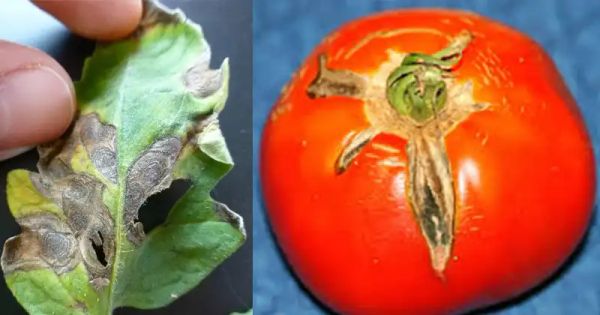Tomatoes are a favorite crop in many gardens, but they can be susceptible to diseases that can hinder their growth. To ensure your tomato plants thrive and produce a plentiful harvest, it’s important to be familiar with the most common diseases, know how to identify them, and understand how to properly care for your plants. In this article, we will discuss the top 10 tomato plant diseases, their identification, and provide tips for treatment and care.

1. Early Blight
Identification: Early blight is characterized by dark brown or black concentric rings on the lower leaves of tomato plants. These spots enlarge and spread as the disease progresses.
Treatment: Remove infected leaves, rotate your crops, and use copper-based fungicides.
2. Late Blight
Identification: Late blight appears as dark, water-soaked lesions on leaves, often with a white, fuzzy growth on the undersides. It spreads quickly during cool, wet weather.
Treatment: Remove infected leaves, ensure good airflow around the plants, and apply copper-based fungicides preventatively.
3. Septoria Leaf Spot
Identification: Septoria leaf spot presents as small, circular brown spots with a lighter center. It primarily affects the lower leaves and can lead to defoliation.
Treatment: Prune affected foliage, mulch to prevent soil splashing, and apply fungicides if necessary.
4. Fusarium Wilt
Identification: Fusarium wilt causes yellowing and wilting of leaves, typically on one side of the plant. Unfortunately, there is no cure for this soil-borne disease.
Treatment: Focus on prevention by planting resistant tomato varieties and sterilizing the soil.
5. Verticillium Wilt
Identification: Verticillium wilt results in yellowing and wilting of lower leaves. When cut, you may notice brown streaks in the plant’s vascular system.
Treatment: Use resistant tomato varieties and avoid planting in soil known to harbor the pathogen.
6. Blossom End Rot
Identification: Blossom end rot is caused by a calcium deficiency and appears as brown, sunken areas at the bottom of the fruit.
Treatment: Maintain consistent soil moisture, provide adequate calcium through soil amendments, and avoid over-fertilization.
7. Tomato Mosaic Virus
Identification: Tomato mosaic virus causes mosaic-like yellow and green patterns on leaves, as well as reduced fruit yield.
Treatment: Remove infected plants promptly to prevent the virus from spreading.
8. Bacterial Spot
Identification: Bacterial spot causes small, water-soaked lesions on leaves and fruit that eventually turn dark and raised.
Treatment: Apply copper-based sprays and avoid overhead watering to reduce disease spread.
9. Tomato Yellow Leaf Curl Virus
Identification: Plants infected with this virus display curled, yellowing leaves and stunted growth.
Treatment: Control the whitefly vector population with insecticides and grow resistant tomato varieties.
10. Powdery Mildew
Identification: Powdery mildew appears as white, powdery spots on leaves, stems, and fruit.
Treatment: Remove affected foliage, improve air circulation, and apply fungicides as needed.
General Tomato Plant Care Tips
- Choose Disease-Resistant Varieties: Select tomato varieties that are known to be resistant to common diseases.
- Practice Crop Rotation: Rotate your tomato plants with different crops each year to prevent soil-borne diseases.
- Water at the Base: Water your tomato plants at the base to keep the leaves dry and reduce the risk of foliar diseases.
- Mulch Around Plants: Apply organic mulch around the base of your tomato plants to maintain soil moisture and prevent soil splashing.
- Prune and Stake Tomatoes: Properly support your tomato plants through staking or caging to improve airflow and reduce humidity.
- Keep the Garden Clean: Regularly remove fallen leaves and other debris to prevent the spread of diseases.
- Reserve Treatments as a Last Resort: Use organic and chemical treatments as a last resort, prioritizing preventative measures.
- Soil Preparation: Conduct a soil test and amend the soil with organic matter to provide a strong foundation for healthy plant growth.
- Proper Spacing: Ensure adequate spacing between tomato plants to promote airflow and reduce the spread of diseases.
- Regular Monitoring: Inspect your plants regularly for any signs of disease or pests for early intervention.
- Companion Planting: Consider planting companion plants that can repel pests and deter diseases.
- Adjust Nutrient Levels: Balance nutrient levels to support healthy fruit development and disease resistance.
- Fertilize Wisely: Apply fertilizer according to the specific needs of your tomato plants, avoiding over-fertilization.
- Proper Pruning Techniques: Prune diseased or damaged foliage promptly and dispose of it properly.
- Support Beneficial Insects: Attract beneficial insects to help control pest populations.
- Quarantine New Plants: Quarantine new tomato plants before introducing them to your garden to prevent disease transmission.
- Record Keeping: Keep a garden journal to track planting dates, varieties, and any disease or pest occurrences.
By following these tips and being proactive in identifying and treating common tomato plant diseases, you can enjoy a healthy and fruitful harvest year after year. Prevention is key, so prioritize creating a favorable environment for your tomato plants to thrive.




